Page 418 of 526
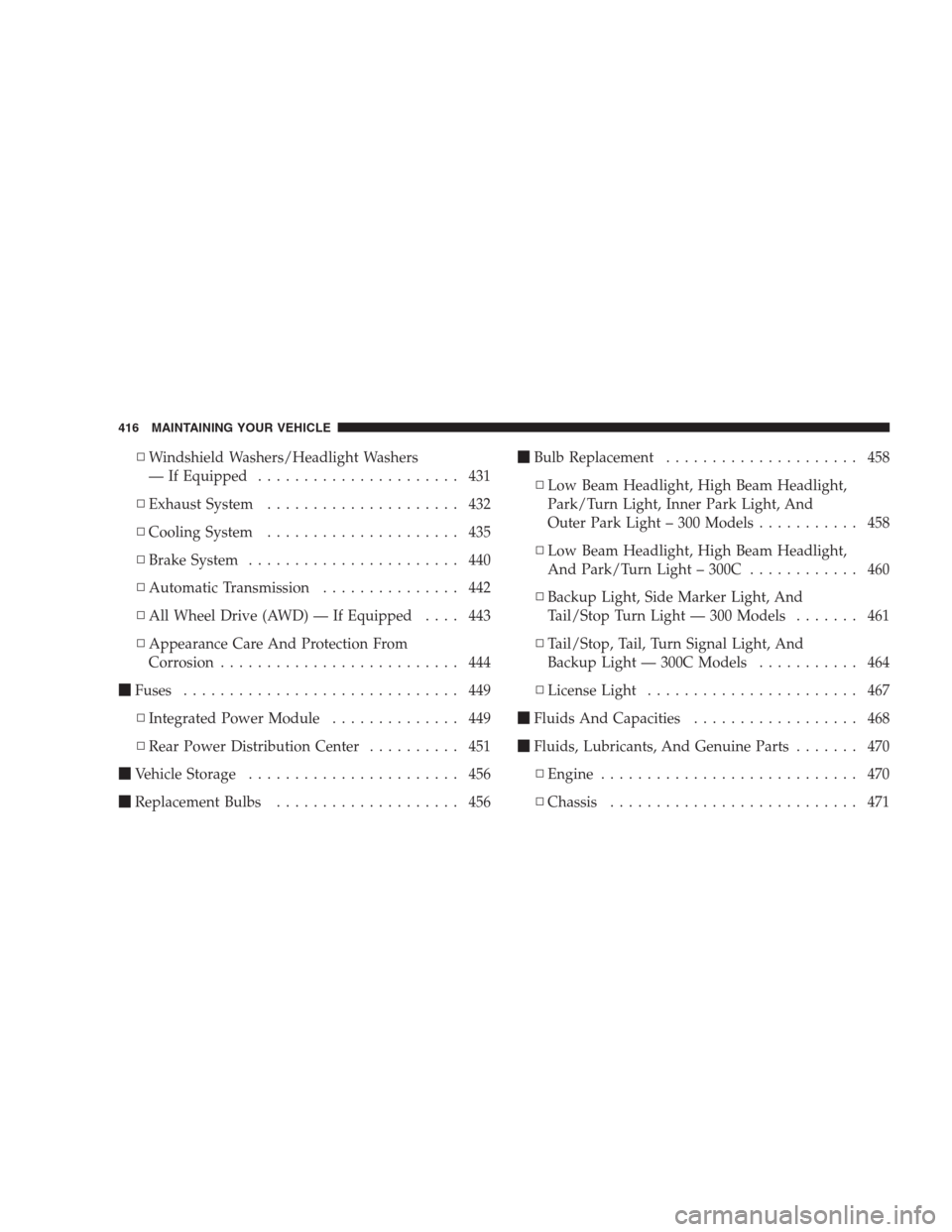
▫Windshield Washers/Headlight Washers
— If Equipped...................... 431
▫Exhaust System..................... 432
▫Cooling System..................... 435
▫Brake System....................... 440
▫Automatic Transmission............... 442
▫All Wheel Drive (AWD) — If Equipped.... 443
▫Appearance Care And Protection From
Corrosion.......................... 444
�Fuses.............................. 449
▫Integrated Power Module.............. 449
▫Rear Power Distribution Center.......... 451
�Vehicle Storage....................... 456
�Replacement Bulbs.................... 456�Bulb Replacement..................... 458
▫Low Beam Headlight, High Beam Headlight,
Park/Turn Light, Inner Park Light, And
Outer Park Light – 300 Models........... 458
▫Low Beam Headlight, High Beam Headlight,
And Park/Turn Light – 300C............ 460
▫Backup Light, Side Marker Light, And
Tail/Stop Turn Light — 300 Models....... 461
▫Tail/Stop, Tail, Turn Signal Light, And
Backup Light — 300C Models........... 464
▫License Light....................... 467
�Fluids And Capacities.................. 468
�Fluids, Lubricants, And Genuine Parts....... 470
▫Engine............................ 470
▫Chassis........................... 471
416 MAINTAINING YOUR VEHICLE
Page 437 of 526
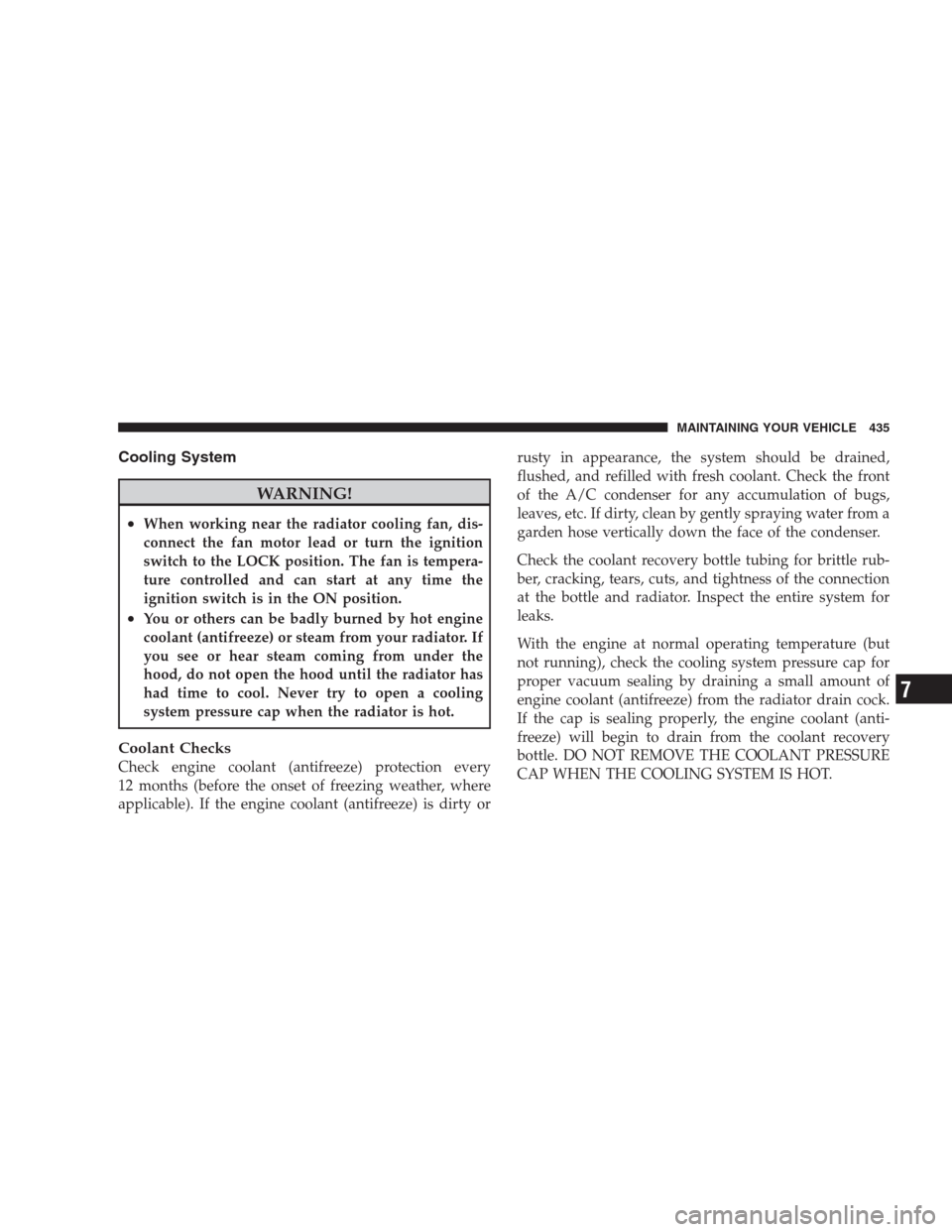
Cooling System
WARNING!
•When working near the radiator cooling fan, dis-
connect the fan motor lead or turn the ignition
switch to the LOCK position. The fan is tempera-
ture controlled and can start at any time the
ignition switch is in the ON position.
•You or others can be badly burned by hot engine
coolant (antifreeze) or steam from your radiator. If
you see or hear steam coming from under the
hood, do not open the hood until the radiator has
had time to cool. Never try to open a cooling
system pressure cap when the radiator is hot.
Coolant Checks
Check engine coolant (antifreeze) protection every
12 months (before the onset of freezing weather, where
applicable). If the engine coolant (antifreeze) is dirty orrusty in appearance, the system should be drained,
flushed, and refilled with fresh coolant. Check the front
of the A/C condenser for any accumulation of bugs,
leaves, etc. If dirty, clean by gently spraying water from a
garden hose vertically down the face of the condenser.
Check the coolant recovery bottle tubing for brittle rub-
ber, cracking, tears, cuts, and tightness of the connection
at the bottle and radiator. Inspect the entire system for
leaks.
With the engine at normal operating temperature (but
not running), check the cooling system pressure cap for
proper vacuum sealing by draining a small amount of
engine coolant (antifreeze) from the radiator drain cock.
If the cap is sealing properly, the engine coolant (anti-
freeze) will begin to drain from the coolant recovery
bottle. DO NOT REMOVE THE COOLANT PRESSURE
CAP WHEN THE COOLING SYSTEM IS HOT.
MAINTAINING YOUR VEHICLE 435
7
Page 438 of 526
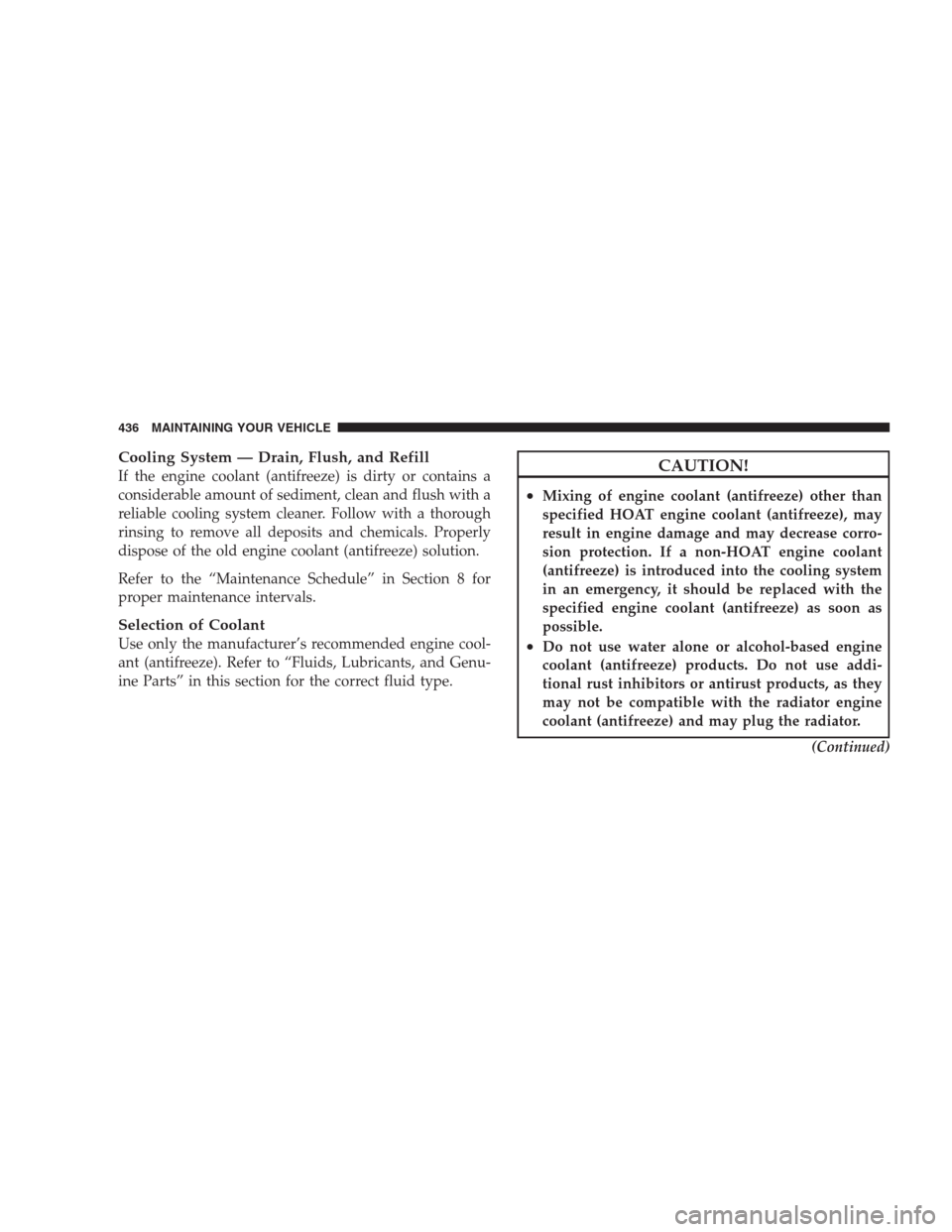
Cooling System — Drain, Flush, and Refill
If the engine coolant (antifreeze) is dirty or contains a
considerable amount of sediment, clean and flush with a
reliable cooling system cleaner. Follow with a thorough
rinsing to remove all deposits and chemicals. Properly
dispose of the old engine coolant (antifreeze) solution.
Refer to the “Maintenance Schedule” in Section 8 for
proper maintenance intervals.
Selection of Coolant
Use only the manufacturer’s recommended engine cool-
ant (antifreeze). Refer to “Fluids, Lubricants, and Genu-
ine Parts” in this section for the correct fluid type.
CAUTION!
•Mixing of engine coolant (antifreeze) other than
specified HOAT engine coolant (antifreeze), may
result in engine damage and may decrease corro-
sion protection. If a non-HOAT engine coolant
(antifreeze) is introduced into the cooling system
in an emergency, it should be replaced with the
specified engine coolant (antifreeze) as soon as
possible.
•Do not use water alone or alcohol-based engine
coolant (antifreeze) products. Do not use addi-
tional rust inhibitors or antirust products, as they
may not be compatible with the radiator engine
coolant (antifreeze) and may plug the radiator.
(Continued)
436 MAINTAINING YOUR VEHICLE
Page 439 of 526
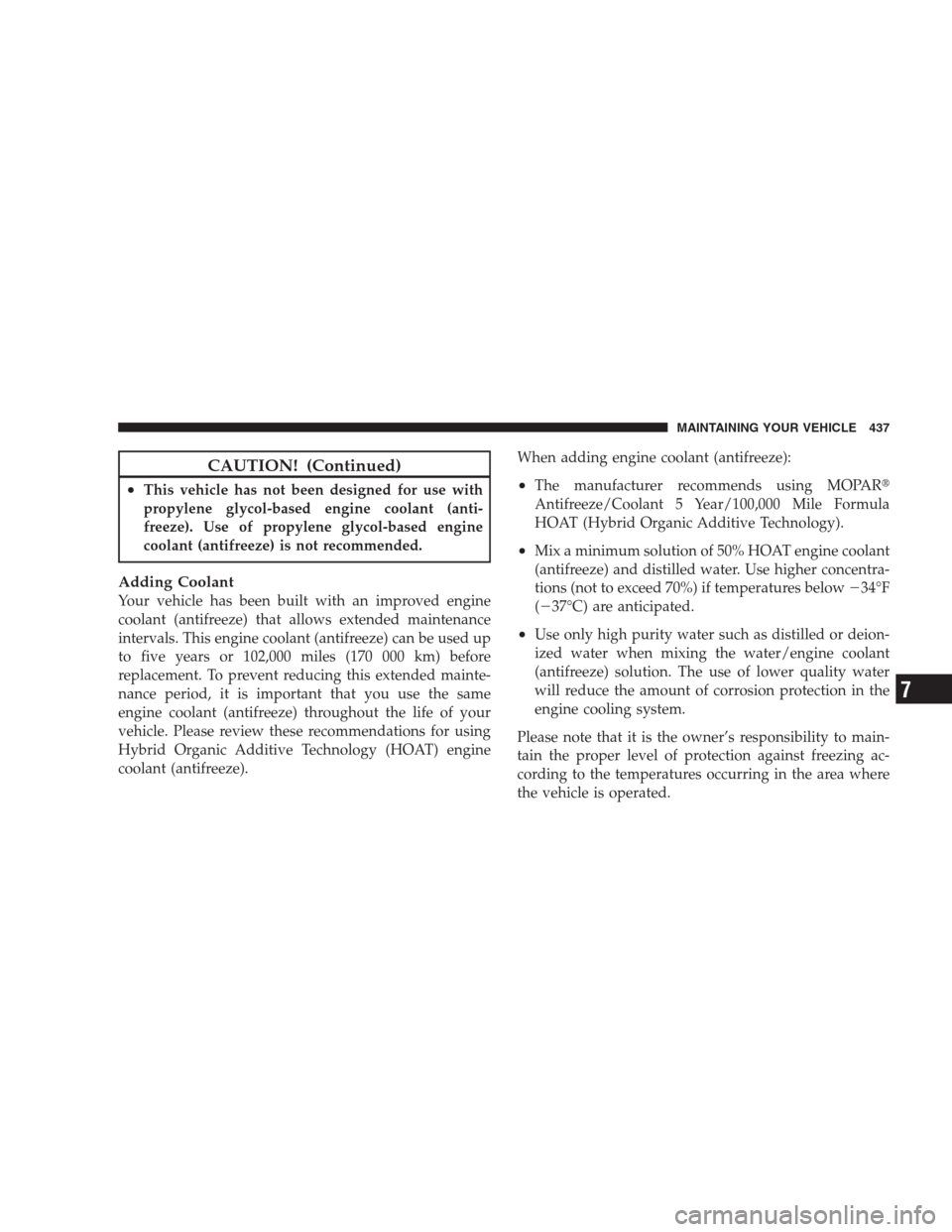
CAUTION! (Continued)
•This vehicle has not been designed for use with
propylene glycol-based engine coolant (anti-
freeze). Use of propylene glycol-based engine
coolant (antifreeze) is not recommended.
Adding Coolant
Your vehicle has been built with an improved engine
coolant (antifreeze) that allows extended maintenance
intervals. This engine coolant (antifreeze) can be used up
to five years or 102,000 miles (170 000 km) before
replacement. To prevent reducing this extended mainte-
nance period, it is important that you use the same
engine coolant (antifreeze) throughout the life of your
vehicle. Please review these recommendations for using
Hybrid Organic Additive Technology (HOAT) engine
coolant (antifreeze).When adding engine coolant (antifreeze):
•The manufacturer recommends using MOPAR�
Antifreeze/Coolant 5 Year/100,000 Mile Formula
HOAT (Hybrid Organic Additive Technology).
•Mix a minimum solution of 50% HOAT engine coolant
(antifreeze) and distilled water. Use higher concentra-
tions (not to exceed 70%) if temperatures below�34°F
(�37°C) are anticipated.
•Use only high purity water such as distilled or deion-
ized water when mixing the water/engine coolant
(antifreeze) solution. The use of lower quality water
will reduce the amount of corrosion protection in the
engine cooling system.
Please note that it is the owner’s responsibility to main-
tain the proper level of protection against freezing ac-
cording to the temperatures occurring in the area where
the vehicle is operated.
MAINTAINING YOUR VEHICLE 437
7
Page 440 of 526
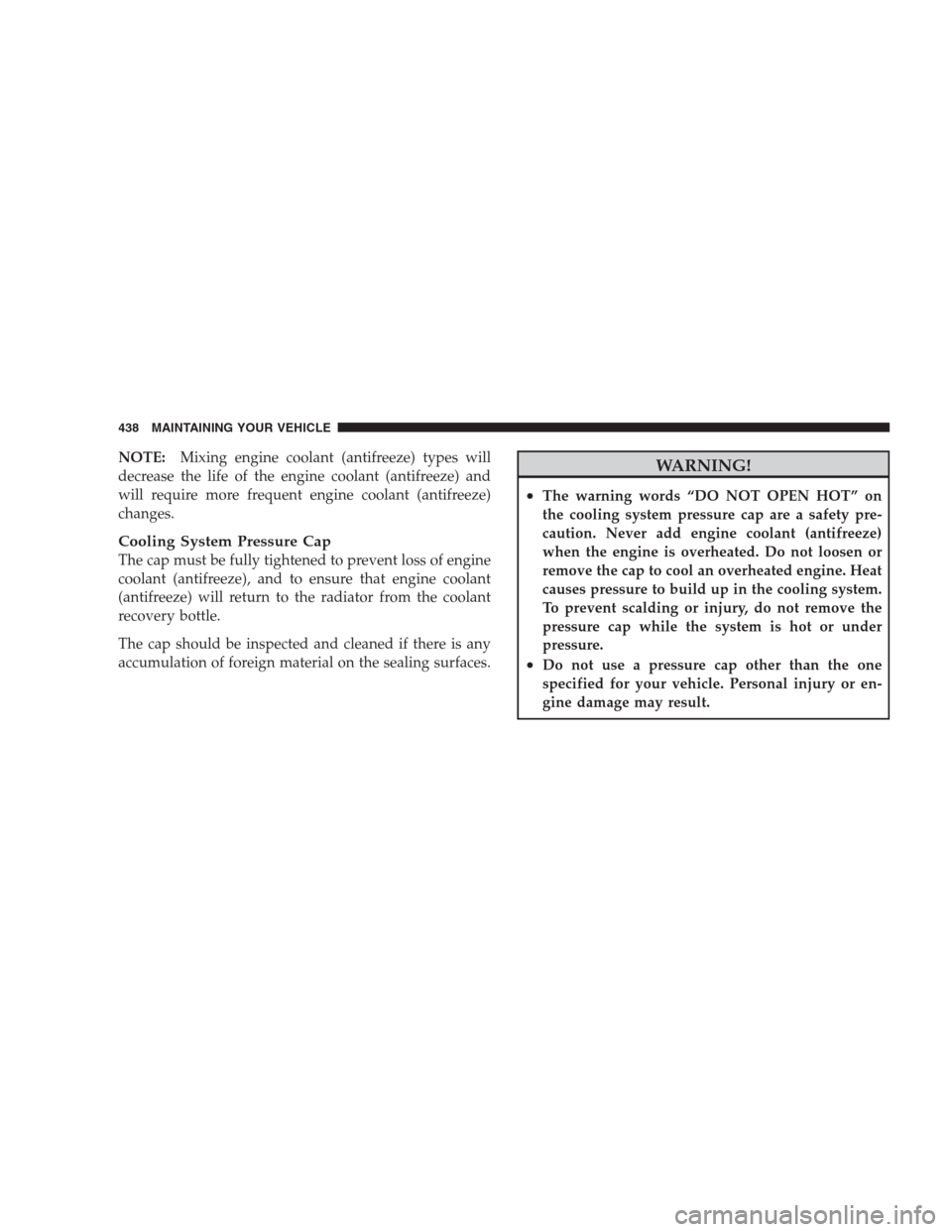
NOTE:Mixing engine coolant (antifreeze) types will
decrease the life of the engine coolant (antifreeze) and
will require more frequent engine coolant (antifreeze)
changes.
Cooling System Pressure Cap
The cap must be fully tightened to prevent loss of engine
coolant (antifreeze), and to ensure that engine coolant
(antifreeze) will return to the radiator from the coolant
recovery bottle.
The cap should be inspected and cleaned if there is any
accumulation of foreign material on the sealing surfaces.
WARNING!
•The warning words “DO NOT OPEN HOT” on
the cooling system pressure cap are a safety pre-
caution. Never add engine coolant (antifreeze)
when the engine is overheated. Do not loosen or
remove the cap to cool an overheated engine. Heat
causes pressure to build up in the cooling system.
To prevent scalding or injury, do not remove the
pressure cap while the system is hot or under
pressure.
•Do not use a pressure cap other than the one
specified for your vehicle. Personal injury or en-
gine damage may result.
438 MAINTAINING YOUR VEHICLE
Page 442 of 526
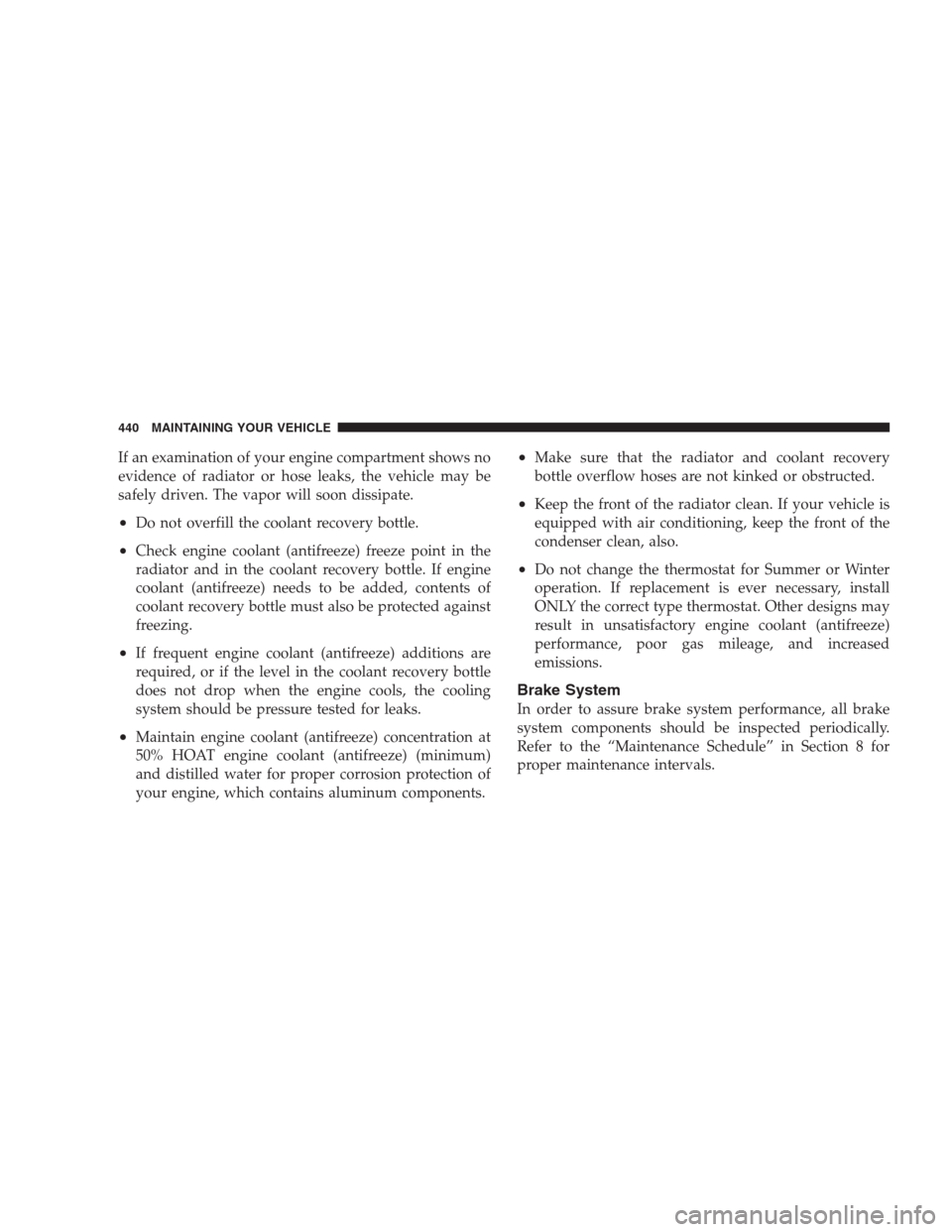
If an examination of your engine compartment shows no
evidence of radiator or hose leaks, the vehicle may be
safely driven. The vapor will soon dissipate.
•Do not overfill the coolant recovery bottle.
•Check engine coolant (antifreeze) freeze point in the
radiator and in the coolant recovery bottle. If engine
coolant (antifreeze) needs to be added, contents of
coolant recovery bottle must also be protected against
freezing.
•If frequent engine coolant (antifreeze) additions are
required, or if the level in the coolant recovery bottle
does not drop when the engine cools, the cooling
system should be pressure tested for leaks.
•Maintain engine coolant (antifreeze) concentration at
50% HOAT engine coolant (antifreeze) (minimum)
and distilled water for proper corrosion protection of
your engine, which contains aluminum components.
•Make sure that the radiator and coolant recovery
bottle overflow hoses are not kinked or obstructed.
•Keep the front of the radiator clean. If your vehicle is
equipped with air conditioning, keep the front of the
condenser clean, also.
•Do not change the thermostat for Summer or Winter
operation. If replacement is ever necessary, install
ONLY the correct type thermostat. Other designs may
result in unsatisfactory engine coolant (antifreeze)
performance, poor gas mileage, and increased
emissions.
Brake System
In order to assure brake system performance, all brake
system components should be inspected periodically.
Refer to the “Maintenance Schedule” in Section 8 for
proper maintenance intervals.
440 MAINTAINING YOUR VEHICLE
Page 471 of 526
Cooling System *
2.7 Liter Engine (MOPAR�Antifreeze/Coolant 5 Year/100,000 Mile
Formula)9.9 Quarts 9.4 Liters
3.5 Liter Engine without All Wheel Drive (MOPAR�Antifreeze/
Coolant 5 Year/100,000 Mile Formula)11.1 Quarts 10.5 Liters
3.5 Liter Engine with All Wheel Drive (MOPAR�Antifreeze/Coolant 5
Year/100,000 Mile Formula)11.4 Quarts 10.8 Liters
5.7 Liter Engine without Severe Duty II Cooling System (MOPAR�
Antifreeze/Coolant 5 Year/100,000 Mile Formula)14.7 Quarts 13.9 Liters
5.7 Liter Engine with Severe Duty II Cooling System (MOPAR�
Antifreeze/Coolant 5 Year/100,000 Mile Formula)15.1 Quarts 14.3 Liters
* Includes heater and coolant recovery bottle filled to MAX level.
MAINTAINING YOUR VEHICLE 469
7
Page 507 of 526
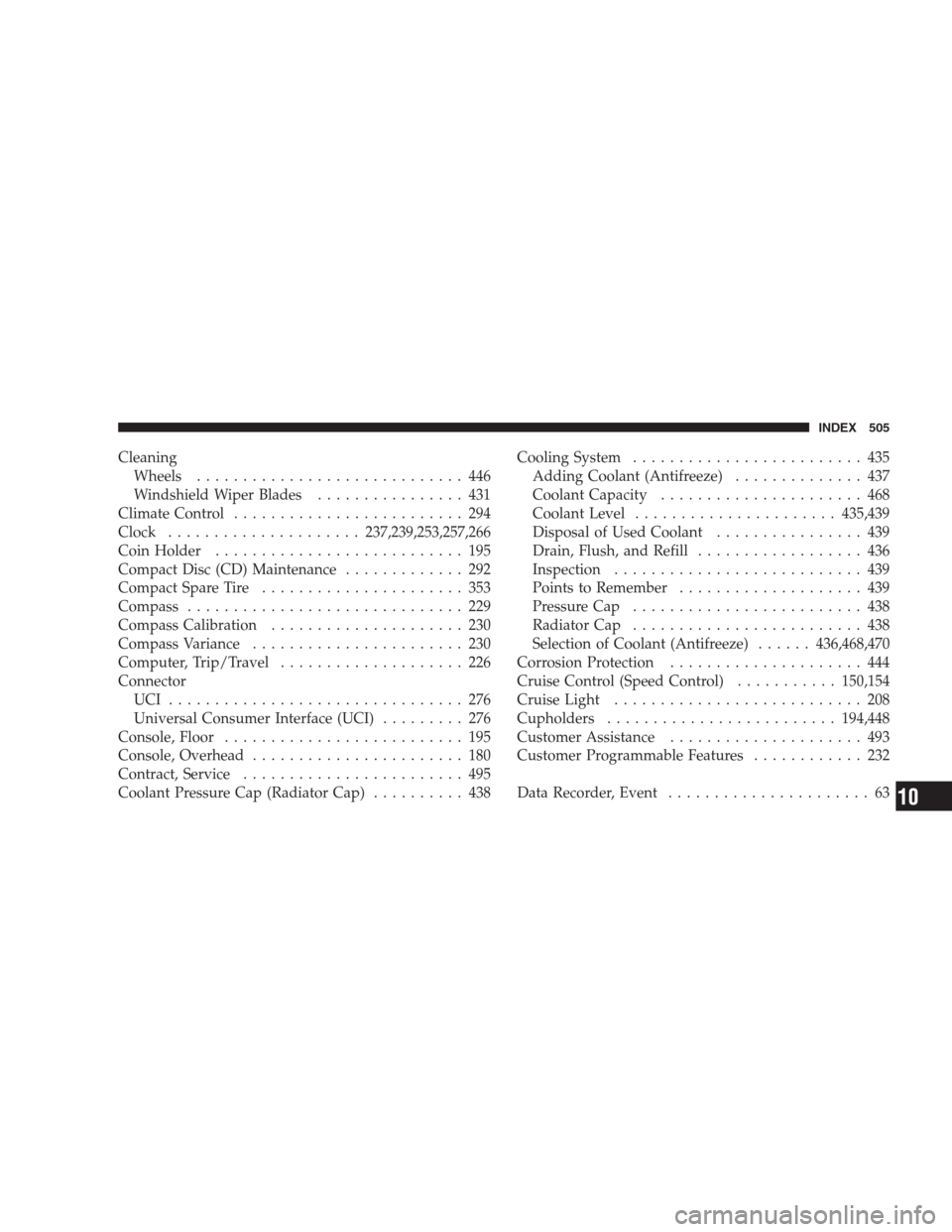
Cleaning
Wheels............................. 446
Windshield Wiper Blades................ 431
Climate Control......................... 294
Clock.....................237,239,253,257,266
Coin Holder........................... 195
Compact Disc (CD) Maintenance............. 292
Compact Spare Tire...................... 353
Compass.............................. 229
Compass Calibration..................... 230
Compass Variance....................... 230
Computer, Trip/Travel.................... 226
Connector
UCI ................................ 276
Universal Consumer Interface (UCI)......... 276
Console, Floor.......................... 195
Console, Overhead....................... 180
Contract, Service........................ 495
Coolant Pressure Cap (Radiator Cap).......... 438Cooling System......................... 435
Adding Coolant (Antifreeze).............. 437
Coolant Capacity...................... 468
Coolant Level......................435,439
Disposal of Used Coolant................ 439
Drain, Flush, and Refill.................. 436
Inspection........................... 439
Points to Remember.................... 439
Pressure Cap......................... 438
Radiator Cap......................... 438
Selection of Coolant (Antifreeze)......436,468,470
Corrosion Protection..................... 444
Cruise Control (Speed Control)...........150,154
Cruise Light........................... 208
Cupholders.........................194,448
Customer Assistance..................... 493
Customer Programmable Features............ 232
Data Recorder, Event...................... 63
INDEX 505
10